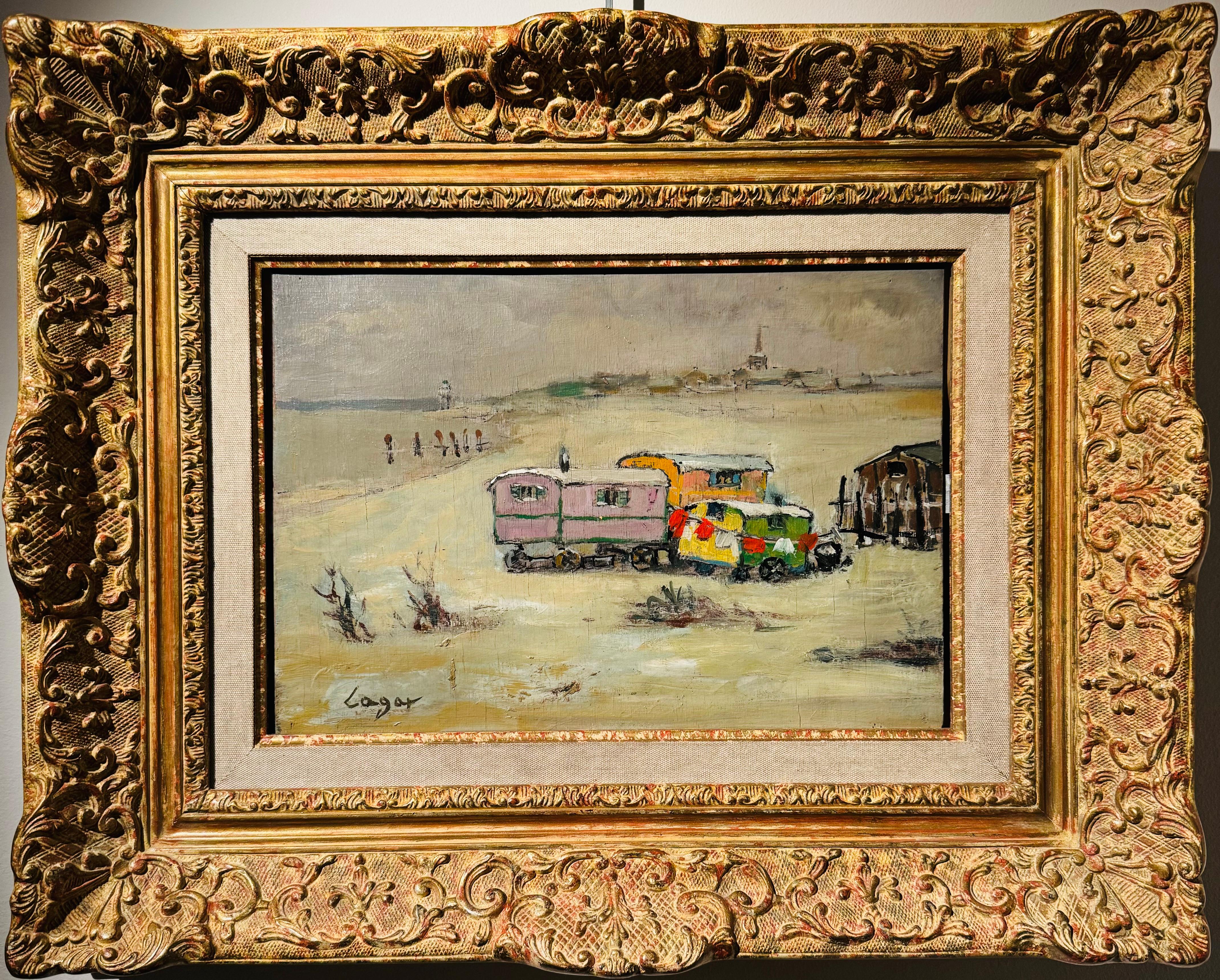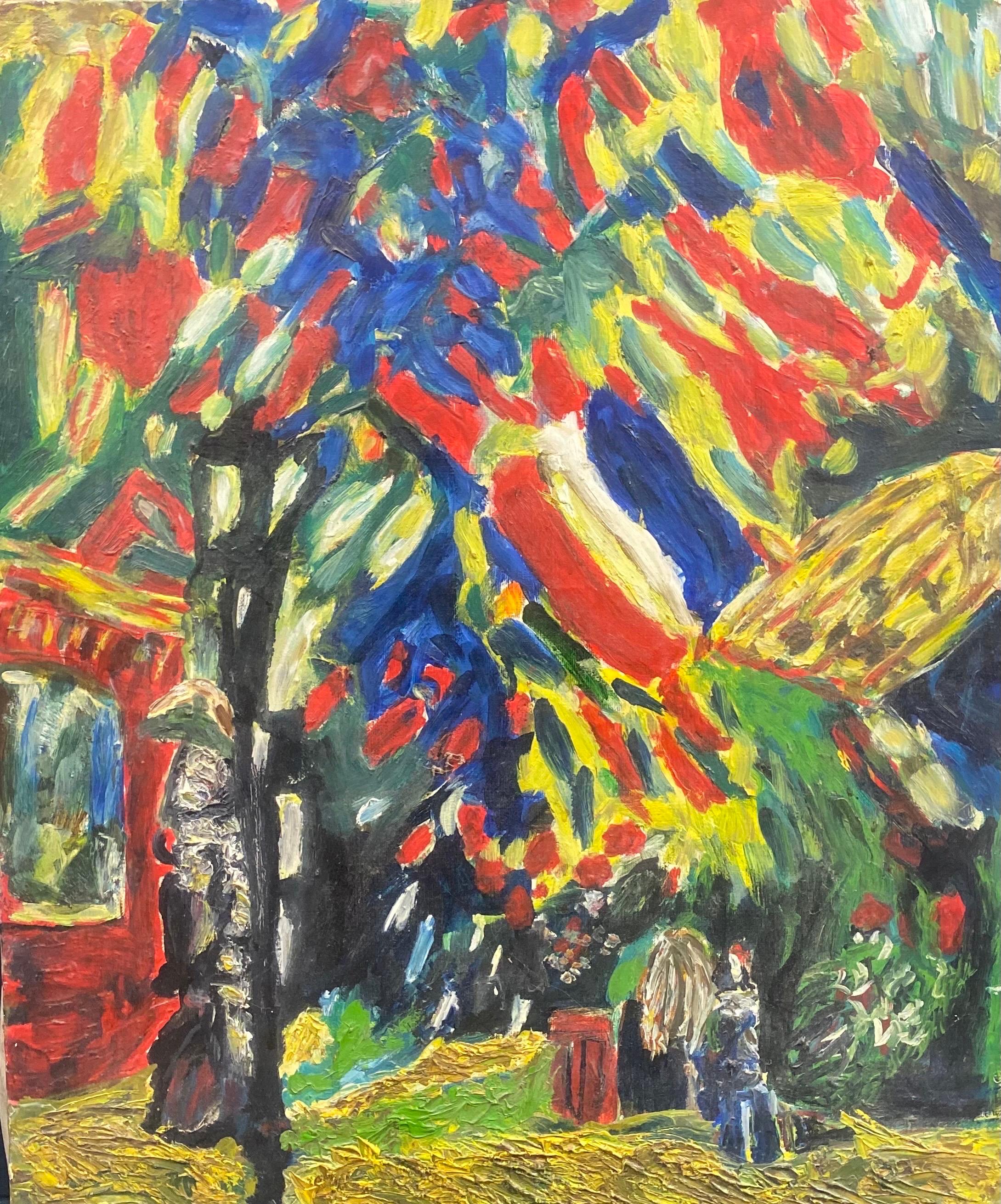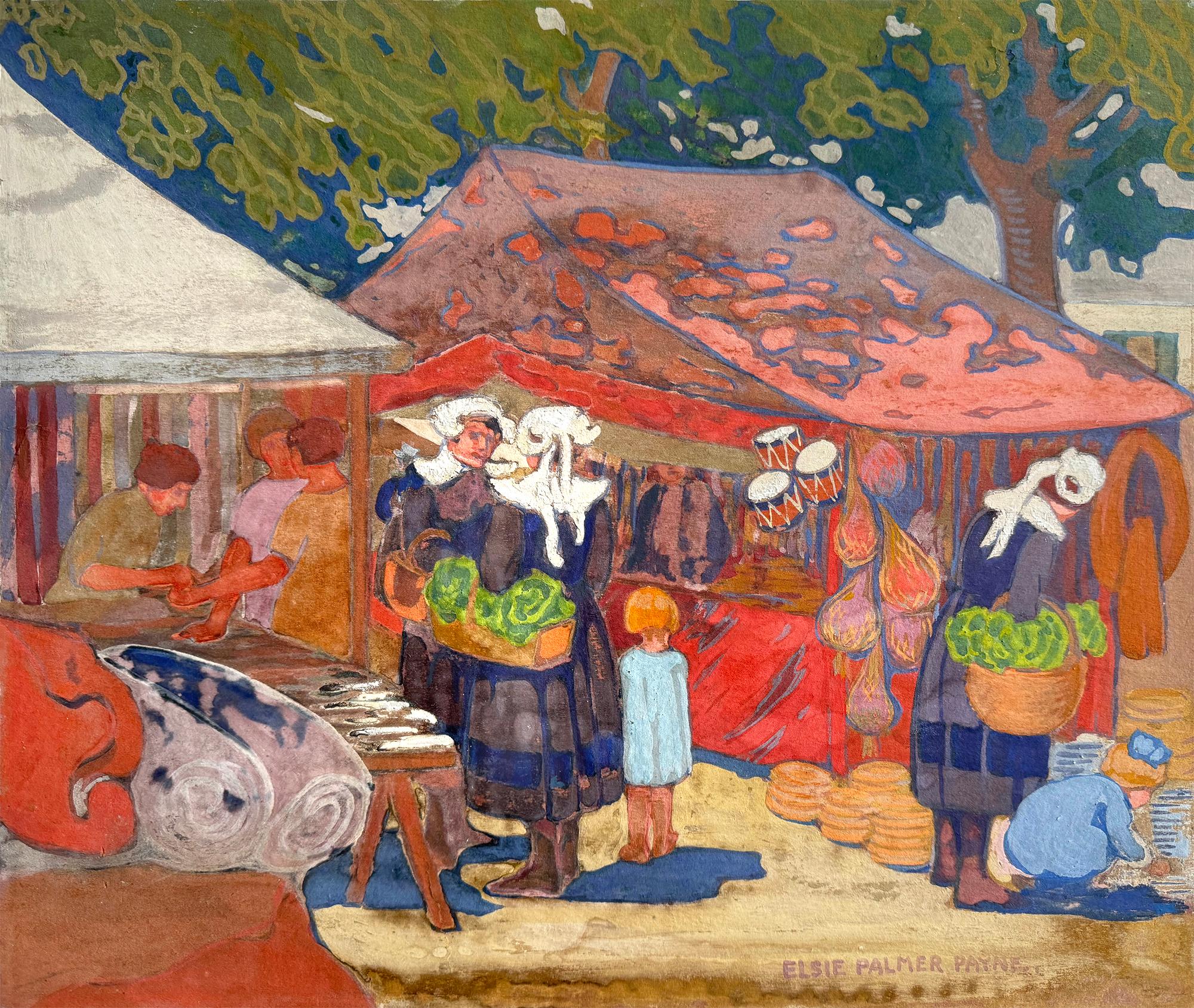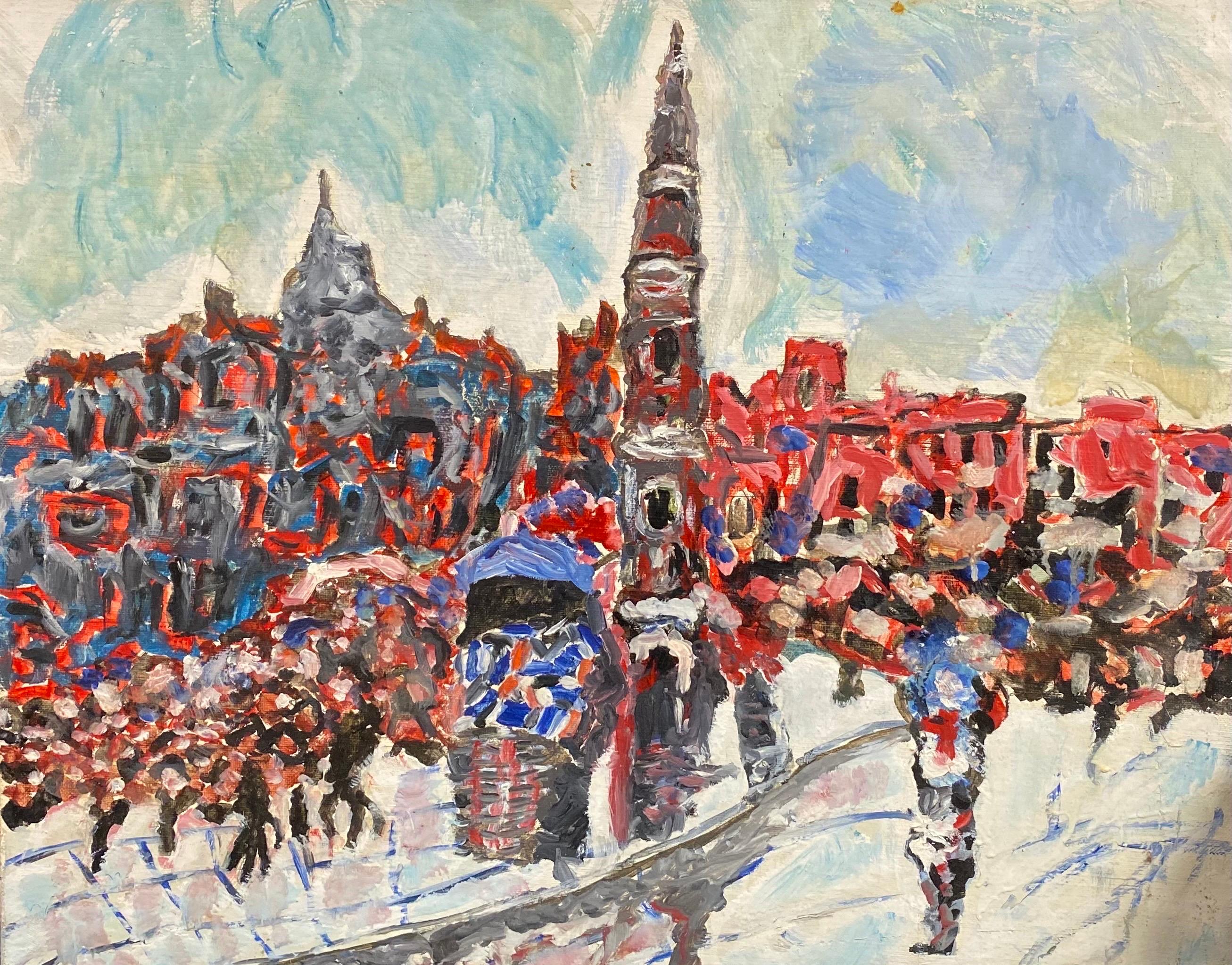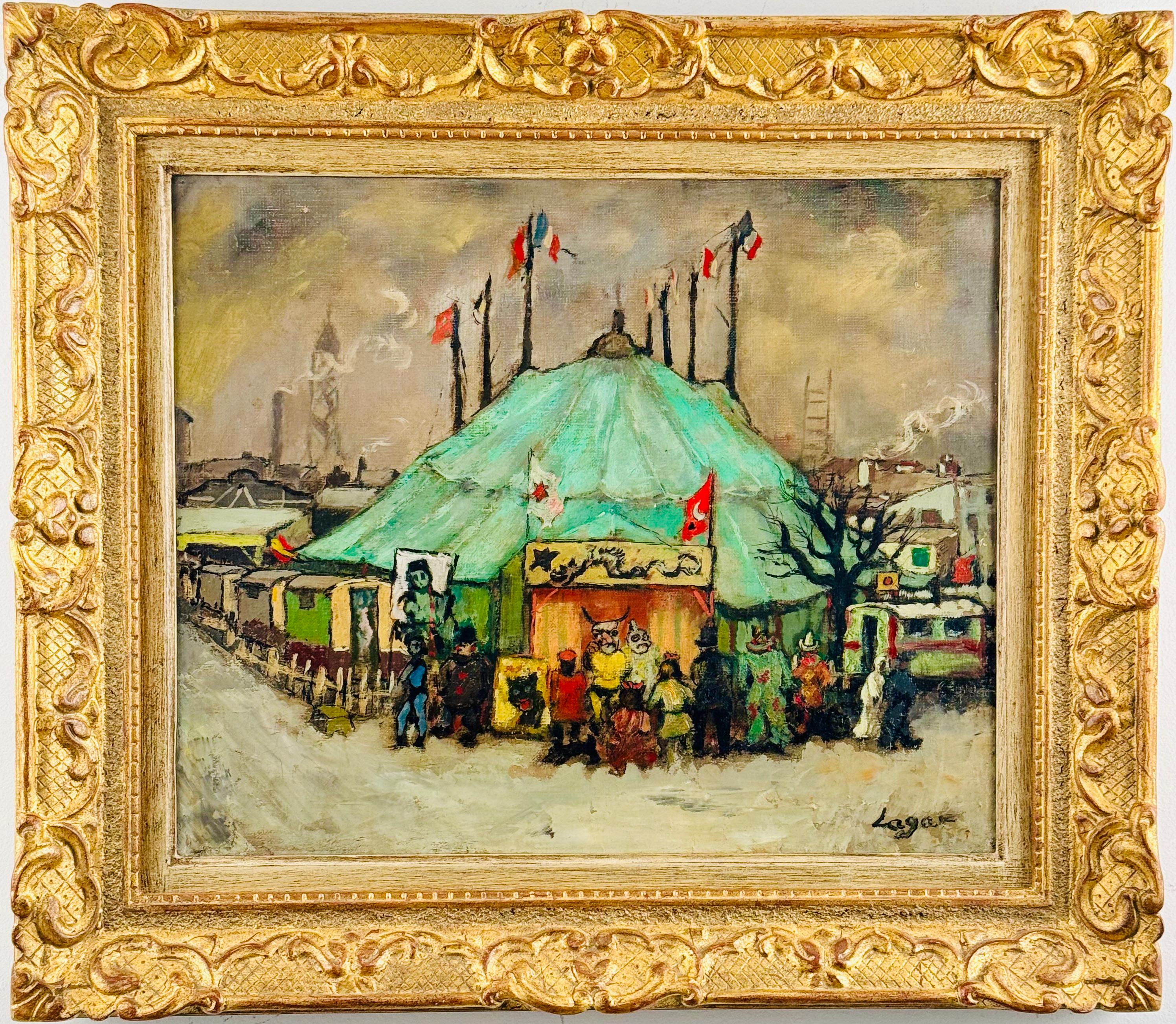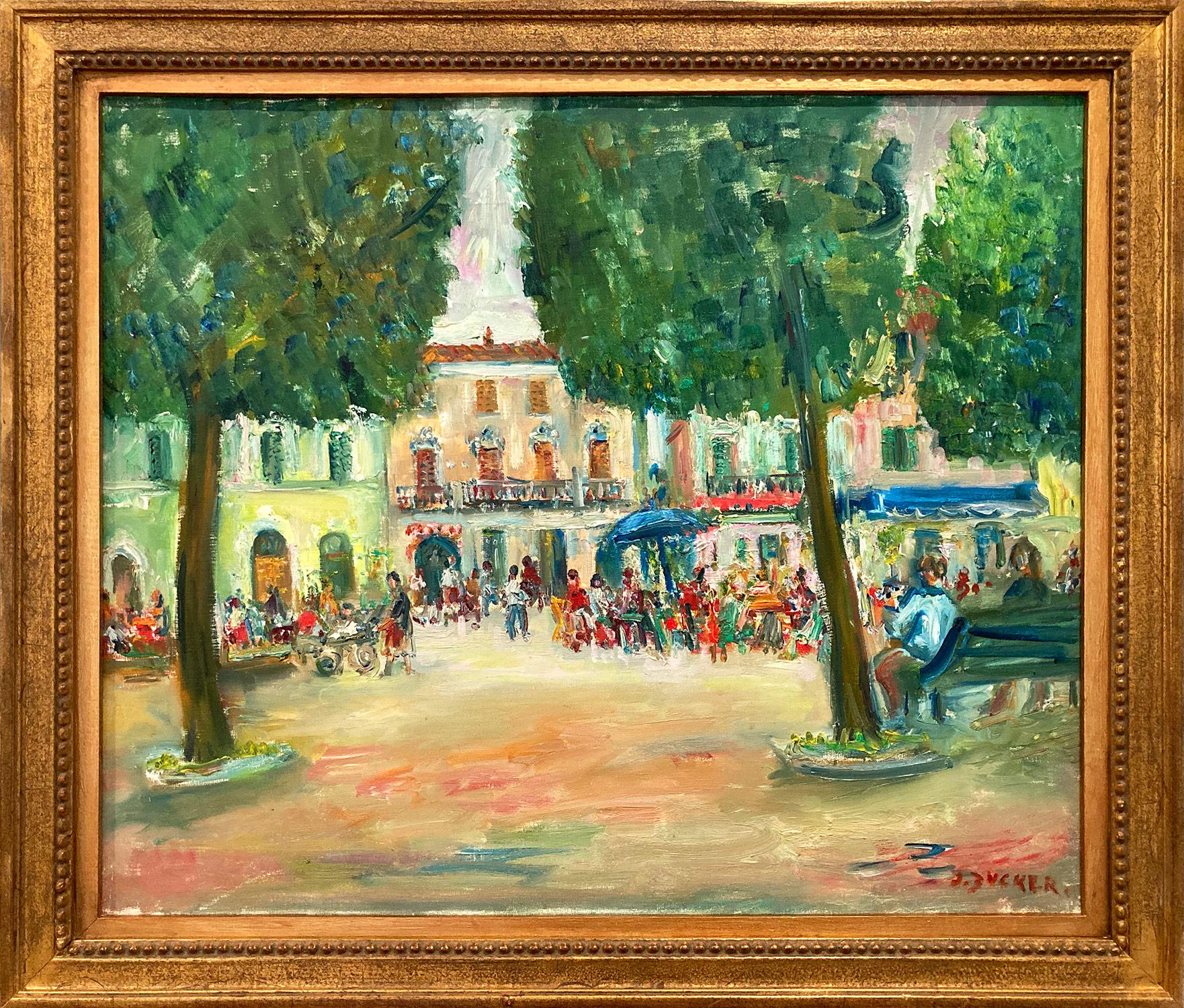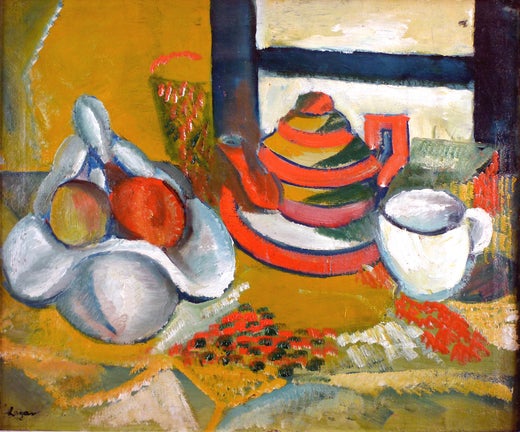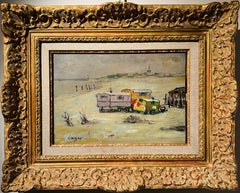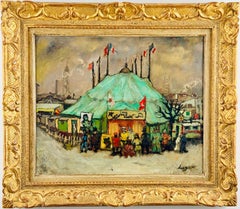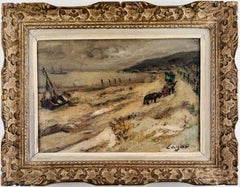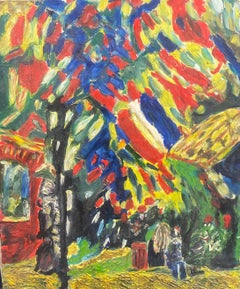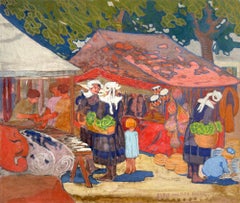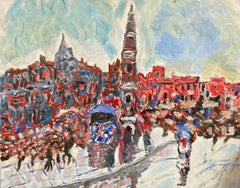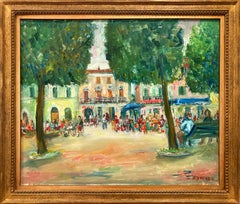Items Similar to Fairgoers in front of roulottes
Want more images or videos?
Request additional images or videos from the seller
1 of 11
Celso LagarFairgoers in front of roulottesCirca 1935
Circa 1935
$17,786.54
£13,367.31
€15,000
CA$24,909.16
A$27,317.69
CHF 14,153.30
MX$328,243.49
NOK 178,165.11
SEK 167,213.05
DKK 114,305.20
About the Item
CELSO LAGAR
Spanish, 1891 - 1966
FAIRGOERS IN FRONT OF ROULOTTES
signed "Lagar" (lower right)
oil on canvas
18-1/4 x 15 inches (46 x 38 cm.)
framed: 29-1/4 x 26 inches (74 x 66 cm.)
PROVENANCE
Private French Collector
Celso Lagar Arroyo (Ciudad Rodrigo, 1891 - Seville, 1966) was an expressionist Spanish painter of the first generation of the School of Paris, where he lived most of his life. He was influenced by avant-gardes of all kinds, such as cubism and fovism. He painted mainly landscapes and still lifes. From a personal point of view, he is a depressive person and completely dependent on his wife, the French sculptor Hortense Begué.
From his native Ciudad Rodrigo, he went to Madrid to be part of the workshop of one of the best sculptors of the moment, Miguel Blay. During 1910 and 1911 he visited Barcelona. Later he studied sculpture in Paris in 1911 advised by Blay, where he met Joseph Bernard, his friend Amedeo Modigliani and his future wife, the French sculptor, Hortense Begué. It will be precisely at that moment when, gradually, he leaves the sculpture in favor of painting.
The outbreak of the First World War will mean, in the life and work of Celso Lagar, the beginning of a new stage. He remained in Barcelona during the war, where he achieved a certain recognition, which allows him to return to Paris. In 1919 he settled permanently in France. His time until the end of the 30s, is the moment of his greatest splendor of the artist. He manages to exhibit his works in the best Parisian galleries, his production is abundant and constant. Both in his residence in Paris and in his rooms, since 1928, in Normandy he will develop an artistic production with very specific themes: still lifes, Spanish reminiscences, landscapes and his celebrated circus scenes. After the period of avant-garde influences of all kinds (Cubism, Fauvism, Vibrationism, Biologism, Simultaneism, Ultraist, ...), Celso Lagar will find his own path marked mainly by Goyesque and Picasian inspiration. Critical and public recognition increases.
With the onset of World War II, its golden age will end. Lagar and Hortense are forced to take refuge in the French Pyrenees amid very difficult living conditions. His return after the liberation of Paris did not have such an impact. Lagar will continue with the same themes and techniques before the war but the public is already looking for new content. Gradually, success fades and economic hardships affect the couple.
At this time around the year 1950, his wife Hortense enters the hospital Broca and in 1955 dies. Lagar falls into a deep depression and will enter the psychiatric hospital of Sainte Anne. His artistic work ends completely. At that time, by court order, two auctions of the works that remained in his workshop are held, to pay for his stay in the asylum. In October 1964 he returned to Spain living in Seville with a sister until his death on September 6, 1966.
His paintings are found in numerous museums throughout Europe, such as: La Rochelle, Goya Museum in Castres, Honfleur (France), Petit-Palais de Geneva, Reina Sofía National Art Center Museum, Casa Lis de Salamanca, Carmen Thyssen Museum ( Malaga) and in prestigious collections such as Crane Kallman (London) or Zborowski (Paris).
He was illustrator of several magazines, among them, the Spanish Magazine Nova, Un enemic del Poble and Troços.
- Creator:Celso Lagar (1891 - 1966, Spanish)
- Creation Year:Circa 1935
- Dimensions:Height: 18.12 in (46 cm)Width: 14.97 in (38 cm)
- More Editions & Sizes:46 x 38 cm.Price: $17,787
- Medium:
- Movement & Style:
- Period:
- Condition:
- Gallery Location:Madrid, ES
- Reference Number:1stDibs: LU1281110334822
Celso Lagar
Celso Lagar Arroyo (Ciudad Rodrigo, 1891 - Seville, 1966) was an expressionist Spanish painter of the first generation of the School of Paris, where he lived most of his life. He was influenced by avant-gardes of all kinds, such as cubism and fovism. He painted mainly landscapes and still lives. From his native Ciudad Rodrigo, he went to Madrid to be part of the workshop of one of the best sculptors of the moment, Miguel Blay. During 1910 and 1911 he visited Barcelona. Later he studied sculpture in Paris in 1911 advised by Blay, where he met Joseph Bernard, his friend Amedeo Modigliani and his future wife, the French sculptor, Hortense Begué. It will be precisely at that moment when, gradually, he leaves the sculpture in favor of painting. The outbreak of the First World War will mean, in the life and work of Celso Lagar, the beginning of a new stage. He remained in Barcelona during the war, where he achieved a certain recognition, which allows him to return to Paris. In 1919 he settled permanently in France. His time until the end of the 30s, is the moment of his greatest splendor of the artist. He manages to exhibit his works in the best Parisian galleries, his production is abundant and constant. Both in his residence in Paris and in his rooms, since 1928, in Normandy he will develop an artistic production with very specific themes: still lifes, Spanish reminiscences, landscapes and his celebrated circus scenes. After the period of avant-garde influences of all kinds (Cubism, Fauvism, Vibrationism, Biologism, Simultaneism, Ultraist, ...), Celso Lagar will find his own path marked mainly by Goyesque and Picasian inspiration. Critical and public recognition increases. With the onset of World War II, its golden age will end. Lagar and Hortense are forced to take refuge in the French Pyrenees amid very difficult living conditions. His return after the liberation of Paris did not have such an impact. Lagar will continue with the same themes and techniques before the war but the public is already looking for new content. Gradually, success fades and economic hardships affect the couple. At this time around the year 1950, his wife Hortense enters the hospital Broca and in 1955 dies. Lagar falls into a deep depression and will enter the psychiatric hospital of Sainte Anne. His artistic work ends completely. At that time, by court order, two auctions of the works that remained in his workshop are held, to pay for his stay in the asylum. In October 1964 he returned to Spain living in Seville with a sister until his death on September 6, 1966. His paintings are found in numerous museums throughout Europe, such as: La Rochelle, Goya Museum in Castres, Honfleur (France), Petit-Palais de Geneva, Reina Sofía National Art Center Museum, Casa Lis de Salamanca, Carmen Thyssen Museum ( Malaga) and in prestigious collections such as Crane Kallman (London) or Zborowski (Paris).
About the Seller
5.0
Vetted Professional Seller
Every seller passes strict standards for authenticity and reliability
Established in 1977
1stDibs seller since 2019
21 sales on 1stDibs
Typical response time: 3 hours
- ShippingRetrieving quote...Shipping from: Madrid, Spain
- Return Policy
Authenticity Guarantee
In the unlikely event there’s an issue with an item’s authenticity, contact us within 1 year for a full refund. DetailsMoney-Back Guarantee
If your item is not as described, is damaged in transit, or does not arrive, contact us within 7 days for a full refund. Details24-Hour Cancellation
You have a 24-hour grace period in which to reconsider your purchase, with no questions asked.Vetted Professional Sellers
Our world-class sellers must adhere to strict standards for service and quality, maintaining the integrity of our listings.Price-Match Guarantee
If you find that a seller listed the same item for a lower price elsewhere, we’ll match it.Trusted Global Delivery
Our best-in-class carrier network provides specialized shipping options worldwide, including custom delivery.More From This Seller
View All"Les Roulottes", 20th Century Oil on Wood Panel by Spanish Artist Celso Lagar
By Celso Lagar
Located in Madrid, ES
CELSO LAGAR
Spanish, 1891 - 1966
LES ROULOTTES
signed "Lagar" (lower left)
oil on wood panel
9-1/2 x 13 inches (24 x 33 cm.)
framed: 17-1/8 x 21-1/2 inches (43.5 x 54.5 cm.)
PROVEN...
Category
1930s Fauvist Figurative Paintings
Materials
Oil, Wood Panel
Pavillon de Cirque
By Celso Lagar
Located in Madrid, ES
CELSO LAGAR
Spanish, 1891 - 1966
PAVILLON DE CIRQUE
signed "Lagar" (lower right)
oil on canvas
15 x 18 inches (38 x 46 cm.)
framed: 21-1/2 x 24-1/2 inches (54 x 62 cm.)
NOTE:
THIS W...
Category
1930s Fauvist Figurative Paintings
Materials
Oil, Canvas
Forains sur la plage
By Celso Lagar
Located in Madrid, ES
CELSO LAGAR
Spanish, 1891 - 1966
FORAINS SUR LA PLAGE
signed "Lagar" (lower right)
signed, located, dated and titled “Lagar Pennedepie sur Honfleur / 1951 / Forains dans la Grove” (o...
Category
1950s Fauvist Landscape Paintings
Materials
Canvas, Oil
"Place Clichy" 20th Century Impressionist Oil on Canvas by Eduardo León Garrido
By Eduardo Leon Garrido
Located in Madrid, ES
EDUARDO LEÓN GARRIDO
Spanish, 1856- 1949
PLACE CLICHY
signed "E. L Garrido" (lower right)
oil on canvas
24-1/8 x 19-3/4 inches (61 x 50 cm.)
framed: 33-1/4 x 28-7/8 inches (84 x 73 cm.)
PROVENANCE
Private Spanish Collector
Fresh and bright view of Clichy Square, Paris, where Leon Garrido offers us his most impressionistic and innovative technique.
The work has a pyramidal composition, from where monument to "Mariscal Moncey" on an 8 meter high pedestal and decorated with bas-reliefs that dominates the entire square.
The florist occupies a central place, from which distinguished figures appear around her. Its delicate and smooth chromaticism in gray and pearly dark almost black and a touch of red.
Eduardo León Garrido (Madrid, 1856 - Caen, 1949) was a Spanish painter. He began his training at the Higher School of Painting in Madrid and as a disciple in Vicente Palmaroli...
Category
Early 1900s Post-Impressionist Landscape Paintings
Materials
Canvas, Oil
"Animated Boulevard, Paris", 19th Century oil on canvas by Gaspar Miró i Lleó
Located in Madrid, ES
GASPAR MIRÓ I LLEÓ
Spanish, 1849 - 1914
ANIMATED BOULEVARD, PARIS
signed "gmiró" (lower right)
oil on canvas
15-1/8 x 22-3/8 inches (38.2 x 56.5 cm.)
framed: 21-1/2 x 28 inches (54.2...
Category
Early 1900s Impressionist Landscape Paintings
Materials
Canvas, Oil
Carlos Nadal, Pont de Ville
By Carlos Nadal
Located in Madrid, ES
CARLOS NADAL
Spanish, 1917 - 1998
PONT DE VILLE
signed "Nadal" (lower right)
titled, signed and dated "PONT DE VILLE / Nadal / 1981" (on the reverse)
with the atelier stamp (on the r...
Category
1980s Fauvist Landscape Paintings
Materials
Oil, Canvas
You May Also Like
Colorful French Fauvist 20th Century Oil Painting on Canvas, Figures in Street
Located in Cirencester, Gloucestershire
Artist/ School: French Fauvist school, 20th century
Title: figures in colorful street scene
Medium: oil painting on canvas, unframed
canvas: 24 x 20...
Category
Mid-20th Century Fauvist Abstract Paintings
Materials
Oil
Fauve Landscape French Market Scene by Female American Artist
Located in Miami, FL
Elsie Palmer Payne was an American Female artist who, in her youth, made several trips to Europe. This French market scene is characterized by a Fau...
Category
1910s Fauvist Landscape Paintings
Materials
Paper, Gouache
Colorful French Expressionist/ Fauvist Oil Painting Busy City Square Figures
Located in Cirencester, Gloucestershire
Artist/ School: French School, circa 1970's, expressionist/ fauvist style.
Title: Busy city street/ square scene with figures
Medium: oil painting on canvas, unframed
canvas: 19...
Category
Mid-20th Century Expressionist Landscape Paintings
Materials
Oil
"Downtown Plaza" Post-Impressionism Landscape Oil Painting with Figures in Plaza
By Jacques Zucker
Located in New York, NY
A charming depiction of children playing by the park in a village setting. The colors are breathtaking, as the impressionistic details are noted with thicker use of paint. The compos...
Category
20th Century Post-Impressionist Landscape Paintings
Materials
Canvas, Oil
Colourful Expressionist Fauvist Market Scene
Located in Cotignac, FR
Colourful Expressionist oil on canvas view of a market scene by A Monis. The painting is signed and dated bottom right and presented in a magnificent custom gilt wood frame.
Provena...
Category
Mid-20th Century Expressionist Figurative Paintings
Materials
Canvas, Oil
Mid 20th Century French Post-Impressionist Oil Busy French Town Street Figures
Located in Cirencester, Gloucestershire
The French Town
Simone Forge 1930-1950's French Impressionist artist
oil on board unframed
board: 16 x 13 inches
inscribed verso
Provenance: private collection, Francec
Condition: gr...
Category
Mid-20th Century Impressionist Figurative Paintings
Materials
Oil
More Ways To Browse
Dior 1955
Roulotte Vintage
Beach Modern Painting
Modern Tree Painting
Painting Boats On A Lake
19th Century Maritime Oil Paintings
Moonlight Painting
Paintings With Houses
Blue Waves Painting
Oil On Canvas Paintings By Walter Landscape
Rare Art Paintings
Wildflower Paintings
Big Sur
View Of Venice
Farmer Painting
Italian Street
Mid Century Painting Signed Bernard
Antique Venice Painting
